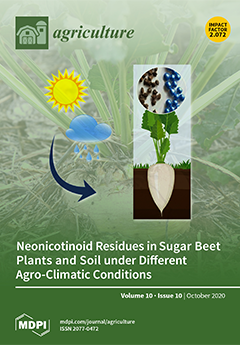The provision of plentiful good-quality food is a primary issue in the modern world. This work was planned to study the influence of packaging atmosphere and oregano (
Origanum vulgare) essential oil addition [(vacuum packaging: T1 or modified atmosphere packaging or T2 (CO
2/N
2 = 4:6) or T3, T2 with oregano essential oil (T2 + EO)] under various storage temperatures (0, 5, 10, and 15 °C) on the control of survival of
Escherichia coli O157:H7 and associated spoilage flora in sliced smoked turkey meat. The pathogen increased by only <1.0 log colony-forming unit (CFU)/g under all packaging and temperature combinations. Moreover, T1, T2, and T3 exerted practically similar inhibitory activity against the pathogen and dominating bacteria, with a relatively low growth of
E. coli O157:H7 in sliced smoked turkey during the shelf life under all storage regimes compared to the control. However, the pathogen survival was highest on the sliced smoked turkey under T1, decreasing by only 0.67, 0.74, 0.63, and 1.30 log CFU/g within 37 days if kept at 0, 5, 10, and 15 °C, respectively. Under T2 and the same condition,
E. coli O157:H7 in the product declined by only 0.31, 0.50, 0.72, and 1.10 log CFU/g within 37 days of storage, respectively. In the T3 samples, the pathogen was reduced by only 0.33, 0.67, 1.72, and 3.46 log CFU/g through 37 days of storage, respectively. Under T3 were
E. coli O157:H7 populations in smoked turkey eliminated (negative by enrichment) under all conditions (after 129, 95, 95, and 43 days maintained at 0, 5, 10, and 15 °C, respectively) compared with other packaging temperature combinations. Thus, T3 contributed to developing ready-to-eat smoked turkey with enhanced product quality and eliminating the pathogen.
Full article





